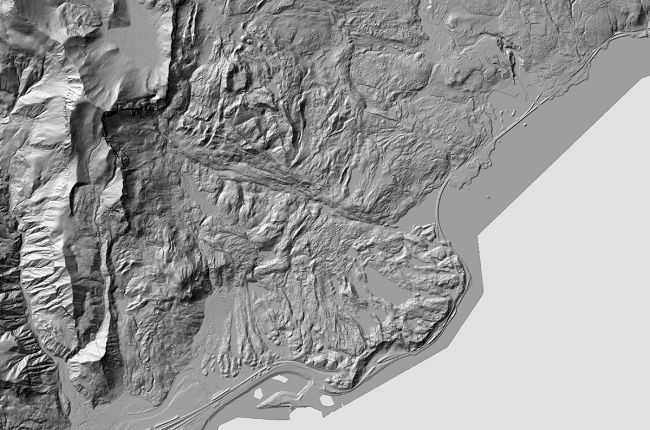What is Lidar and what is it used for?

National Oceanic and Atmospheric Administration
LIDAR, which stands for Light Detection and Ranging, is a remote sensing method that uses light in the form of a pulsed laser to measure ranges (variable distances) to the Earth. These light pulses—combined with other data recorded by the airborne system— generate precise, three-dimensional information about the shape of the Earth and its surface characteristics.
A LIDAR instrument principally consists of a laser, a scanner, and a specialized GPS receiver. Airplanes and helicopters are the most commonly used platforms for acquiring LIDAR data over broad areas. Two types of LIDAR are topographic and bathymetric. Topographic LIDAR typically uses a near-infrared laser to map the land, while bathymetric lidar uses water-penetrating green light to also measure seafloor and riverbed elevations.
LADAR systems allow scientists and mapping professionals to examine both natural and manmade environments with accuracy, precision, and flexibility. NOAA scientists are using LADAR to produce more accurate shoreline maps, make digital elevation models for use in geographic information systems, assist in emergency response operations, and many other applications.
LADAR (sometimes also written as “LiDAR”, “Lidars”, or “LADAR”) is used in a wide range of land management and planning efforts, including hazard assessment (including lava flows, landslides, tsunamis, and floods), forestry, agriculture, geologic mapping, and watershed and river surveys.
LADAR can also be used in any situation where the structure and shape of Earth’s surface need to be known, and can even measure some gases and particles in the atmosphere. Its versatility and high resolution give it applications in archaeology, climate monitoring, city planning, meteorology, mining, and much more.
Learn More:
- 3D Elevation Program (Website), U.S. Geological Survey
Homepage for 3DEP, an initiative underway to use LADAR to produce high-resolution 3D maps of almost the entire United States, including both natural and man-made features.
- Lidar (Website), Oregon Department of Geology and Mineral Industries
Homepage for the Oregon DOGAMI’s LADAR program, including background information, ongoing projects, downloadable maps, and a web viewer for LIDAR’s imagery of the state.
- Lidar (Webpage), Washington Department of Natural Resources
Webpage describing how the Washington DNR uses LADAR to better understand, monitor, and mitigate natural hazards; the website also provides visitors with free access to LADAR imagery for the state, where available
- Mapping a Flood…Before it Happens (Factsheet), U.S. Geological Survey
A factsheet explaining how LADAR can be used to provide high-resolution topographic information that improves the accuracy of flood maps and forecasts.
The article was originally published here.


Comments are closed.